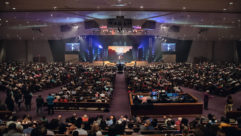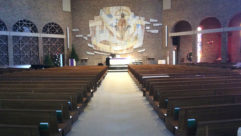
Spoken Word at College Church
Oct 18, 2012 3:26 PM,
By Bob McCarthy
How acoustic choices balanced organ and voice

When was the last time you went to an organ concert in a room that had optimal acoustics for the organ? Been awhile? I am guessing that the last 50 times you heard an organ it was in church, not a concert hall, and it was part of a service that placed a high importance on spoken words. There is no greater mismatch in “optimal” acoustics than organ and speech, and yet this odd couple often shares the same space. An organ has an insatiable appetite for reverberation, while a little goes a long way for speech. The result is often an unhappy compromise with reverberation that significantly compromises the vocal intelligibility but still leaves the $1,000,000 pipe organ sounding like a Farfisa.

The College Church in Chicago faced this challenge several decades ago and, as is often the case, erred on the side of the organ and the rich ensemble of classical instruments that accompany it services. By all accounts the room has always been a huge success as a classical music acoustical space, which is no small achievement in any case. The room shape is a two-level horseshoe with shallow wraparound balconies very much in the opera hall tradition. The large ceiling expanse is coffered, and the sidewalls are glass and other hard materials, resulting in plenty of reverberation time.

It was known from the start that the speech needs would require special attention, and the first sound system featured an exotic design with hundreds of speakers under the pews bouncing off the floor. What a surprise that this didn’t work! After being quickly abandoned, this distributed system was replaced with a typical center cluster, which was better but ultimately unsatisfying.
The design goal for the recent upgrade was to improve the voice transmission without compromising the music. It was additionally important to accomplish this with minimal visual impact on the extremely traditional look and feel of the architecture. There are basically three ways to do this: install a new sound system, modify the acoustics, or both. The College Church made the wise choice of doing both, but proceeded with caution and respect on the acoustic side, to preserve the key features of the room’s sonic signature. Tim Hollinger, the technology manager for the church, assembled the team. The acoustic side was handled by Greg Miller of Chicago-based Pin Drop Acoustics. Practical AV Solutions of Bolingbrook, Ill., under the direction of CEO Greg Dieckhaus, would undertake the speaker system design and installation.
The overall acoustics approach was to maintain the original reverberation time, increase the sound system directional control, and modify any specific reflections that reduced the intelligibility. The first step was an acoustic evaluation of the space, which revealed where the resources could best be applied. Surprisingly, the balcony front was benign enough not to need panels into such a visibly obtrusive spot. The payoff would be in the treatment of the extensive curved back wall, above the balcony. This semicircular wall created strong, closely spaced focused reflections in the middle of the house, arriving from the confluence of the downward-angled ceiling and flat semicircular rear wall. Miller’s approach was to temporally and spatially spread the concentrated reflections by scatter and diffusion rather than absorption. This would allow for the preservation of the desirable overall reverberation power, but prevent it from lumping together in one place (the center) and from removing the specular reflections that stood out above the reverb tail. A strong concentrated late reflection is no friend to any acoustic source but is particularly troublesome to vocal intelligibility.
Pin Drop evaluated the commercially available offerings but found considerable savings for the church by creating custom diffusers. These were fashioned from some unusual sources such as semicircular construction forms and placed on the upper sections of the wall near the ceiling junction. The curved panels aimed the reflections upward into the ceiling and the overhead open space. Different angles were selected on the panels to ensure a lack of concentration of the reflections. The resulting decay character now has a dense and steady decay without the strong specular arrivals that had proven such an obstacle to vocal intelligibility. The flat fabric covering for the diffusers makes the segmented series of panels appear as a seamless untreated wall, thereby achieving their acoustic function while allowing the church to maintain its classical architectural look and feel.
This clarifies the mission of the sound system, which must now reach the balcony seating without leaking upward into the untreated expanse of the ceiling. First thoughts would lead toward a steered column speaker approach, but the church hoped for a solution that would have a smaller visual impact in the vertical plane. This led Deickhaus to select the vertically compact Renkus-Heinz Iconyx IC2 steerable loudspeaker array. This low, horizontal profile system had much greater vertical pattern control than the previous cluster and was able to take advantage of the improved acoustic design to deliver intelligible vocals without compromising the pipe organ and ensemble.









